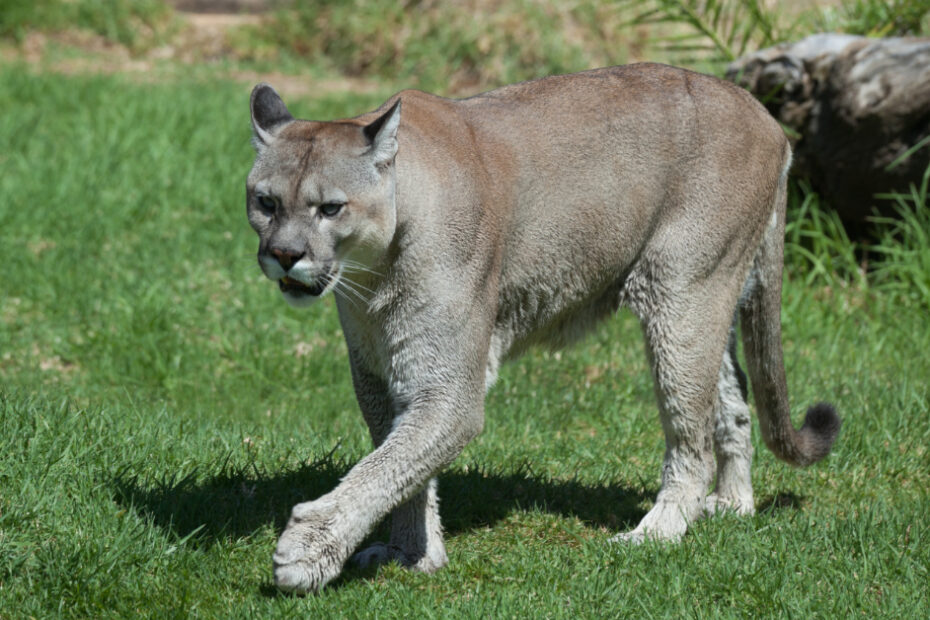The United Kingdom is home to a variety of different big cats, including black pumas, brown pumas, lynx, bobcats and panthers. We receive hundreds of sighting reports every year and these are the most common species.
While these animals are seldom seen, there have been a number of sightings in recent years. In this blog post, we’ll take a look at the different types of big cats that can be found in the UK and where they are most likely to be spotted.
Puma
Pumas are another type of big cat that is commonly found in Britain. There are two main types of puma which get reported in UK sightings – black pumas and brown pumas – which can be distinguished by their coat colouration. Black pumas have a completely black coat, while brown pumas have a brown, tawny, or reddish-brown coat.
Pumas can reach lengths of up to 7 feet and weigh up to 200 pounds when fully grown. These animals typically live in mountainous regions, but can also be found in forests and grasslands.
Black pumas are UK’s most frequently spotted big cat. They are usually solitary animals but have been known to form small groups. These cats are most often found in wooded areas near urban areas.
Brown pumas are slightly less common than black pumas. They tend to live in rural areas and are often seen near rivers or streams.
View our latest puma sightings here.
Lynx
Lynx are a type of wild cat that is native to Europe, Asia and North America. There are three species of lynx – the Eurasian lynx, the Canadian lynx and the Iberian lynx. The Eurasian lynx is the only species that can be found in the UK. These cats are shy and secretive animals that live in woodlands.
Eurasian lynxes have grey or reddish-grey fur with white spots. They typically grow to be about 3 feet long and weigh between 15 and 30 pounds when fully grown.
View our latest lynx sightings here.
Bobcat
Bobcats are smaller than most of the other big cats on our list, but they are still an impressive sight. These animals typically have tan fur with dark spots, although some bobcats can be completely black.
One of the easiest ways to tell a bobcat apart from other types of big cats is by its tail; bobcats have short tails that are about 4 inches long, while other types of big cats have tails that are much longer.
Bobcats typically grow to be about 2 to 3 feet long and weigh between 15 and 30 pounds when fully grown.
Panther
Panthers are a type of big cat which although they can be found in many parts of the world, they are very rare in the UK.
Although they are not technically a separate species from other panthers, black panthers are usually considerably larger than their counterparts. These animals are often confused with jaguars or leopards, but there are some key physical differences that set them apart.
Black panthers have a solid black coat with no spots, whereas leopards have a spotted coat with black spots against a yellow background. Jaguars, on the other hand, have a spotted coat with black spots against a tan or orange background.
Brown panthers are very similar to black panthers in terms of appearance, although they get their name from their brown coat. These felines can be found all over Europe and Asia, and sometimes even Africa. In terms of size, they can grow up to 6 feet long and weigh anywhere between 200 and 500 pounds.
View our latest panther sightings here.
Scottish Wildcat
These are the smallest big cats found in the UK and are known as the “tiger of the Highlands” – as they’re usually only found in the most remote areas of Scotland.
They can sometimes look very similar to a very large tabby cat, but they are stockier with a fluffier, blunt tail.
They are very shy and are almost entirely nocturnal, lying in their dens in the daytime or if the weather is bad.
Usually, they’ll feed on rabbits and ground-nesting birds on moorland and in woodlands.
It is listed as Critically Endangered in the United Kingdom and is threatened by hybridization with domestic cats.

If you’re lucky enough to spot one of these magnificent animals, make sure to report your sighting using this form.

OP: You may wish to revise the content of this article, it is unfortunately littered with inaccuracies, which does absolutely no favours for your credibility and merely serves to demonstrate the limitations of your scientific understanding and the resulting spreading of disinformation.
If you were to clarify which genus, each of these ‘species’ are in, you may find some interesting revelations.
Panthers are not a separate species of cat, the name can relate to any member of the panthera genus (Lions, Tigers, Jaguar, Leopards and Snow Leopards). When people talk of seeing black panthers, they refer to either black jaguar or black leopards. Incidentally there is no such thing as a black puma.